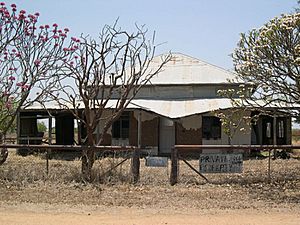Antbed House facts for kids
Quick facts for kids Antbed House |
|
|---|---|

Antbed House, 2004
|
|
| Location | South Street, Georgetown, Shire of Etheridge, Queensland, Australia |
| Design period | 1870s - 1890s (late 19th century) |
| Built | c. 1890 |
| Official name: Antbed House | |
| Type | state heritage (built) |
| Designated | 26 November 1999 |
| Reference no. | 601628 |
| Significant period | 1890s (fabric) 1890s-1910s (historical) |
| Significant components | residential accommodation - main house, trees/plantings |
| Lua error in Module:Location_map at line 420: attempt to index field 'wikibase' (a nil value). | |
Antbed House is a special old house in Georgetown, Australia. It was built around 1890. What makes it unique is that its bricks are made from "antbed." This is a special type of earth found in termite mounds. People usually used antbed for floors or tennis courts, but rarely for building entire houses. This house is the only one of its kind known in North Queensland towns. It is now protected as a heritage site.
Contents
History of Antbed House
Building a Gold Rush Town
Georgetown started as a town called Etheridge in 1870. This was after gold was found nearby. The town was later renamed Georgetown to honor Howard St George, an important gold commissioner. Many people rushed to the area in 1869 when gold was first discovered. By 1871, Georgetown had about 600 people. It became the main center for the goldfields.
Because timber was hard to find, most buildings in Georgetown were made from timber frames and corrugated galvanised iron. The Antbed House was built around 1890. It was likely a home for a mine manager.
The Special Antbed Bricks
The Antbed House is very unusual because it's made from bricks created using earth from termite mounds. This material is called "antbed." While antbed was sometimes used for floors or to seal buildings, it was very rare to use it for making bricks for a whole house.
In the late 1880s, a British mining company, Goldfields of North Queensland Limited, applied for the land where the Antbed House now stands. It's believed the house was built for their manager in 1889 or 1890. It was a large home with a living room, a wide hallway, and two bedrooms. It also had wide verandahs all around and a separate kitchen made of antbed at the back. This house looked much grander than most other homes in Georgetown at the time.
Who Lived Here?
Over the years, the Antbed House had several owners. In 1896, a grazier named Marmaduke Curr applied for the lease. The house was valued at £200 then. Later that year, the lease was transferred to Louisa Boyle. Her husband was a bank manager and later a mining manager in Georgetown.
In 1902, the house was transferred to Thomas Everett, who owned the local newspaper, The Mundic Miner. A photo of the Everett family in front of the house even appeared in a newspaper in 1907. The Everetts lived there until about 1917. After them, the house changed hands many times, though not all changes were officially recorded.
In 1946, the Aylett family, who had been living in the house since 1944, wanted to get a lease for the property. In 1950, they officially became the leaseholders. The Ayletts kept the lease until 1978. Since then, it has been owned by a few different families. In 1994, the property became freehold, meaning it was fully owned by the Pedracini family.
What Antbed House Looks Like
Outside the House
The Antbed House has a rectangular shape, about 8 meters by 9 meters. It has a steeply sloped roof made of corrugated iron. A curved verandah, also made of corrugated iron, goes around the house. It is supported by timber posts.
The walls of the house are about 3.5 meters high. They are made from earth bricks that are about 20 cm long, 9 cm high, and 11 cm wide. The outside walls are two bricks thick, and the inside walls are one brick thick. The bricks are laid in a special pattern. The outside of the house is covered with a lime coating. This coating is scored to look like stone blocks, with black lines added to make it seem even more like stone.
Inside the House
The timber floor of the verandah has been replaced with concrete. Most of the house also has concrete floors. However, one room still has its original timber floorboards. You can even see layers of old linoleum on this floor. The inside of the house is open right up to the roof. It's not clear if there was ever a ceiling, but it seems unlikely.
Why Antbed House is Important
Antbed House was added to the Queensland Heritage Register in 1999. This means it is a very important historical site.
A Unique Building Material
The Antbed House is special because it's a rare example of a house built using adobe bricks made from antbed. This shows how people in Queensland's far northern goldmining towns had to be creative. They used materials that were available and affordable, since other building materials were hard to get. Most buildings in remote goldfields were made of timber or iron, making this adobe house very unusual.
A Link to the Past
This house helps us understand the history of Queensland. It shows what life was like in Georgetown when it was a busy gold mining center around 1890. Studying the Antbed House can teach us a lot about how people built homes in the past, especially with unique materials like antbed.
Valued by the Community
The Antbed House is also important to the people of Georgetown. They see it as a unique and historical part of their town. Visitors are often directed to see this special house.

